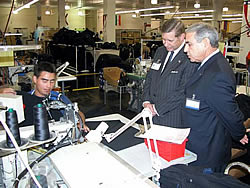The President's Management Agenda
It is the Department of Commerce’s stated mission to promote job creation and improve living standards for all Americans by fostering economic growth, technological competitiveness, and sustainable development. In meeting this obligation to the American taxpayer, the Department fully appreciates the importance of sound management practices and is intent on applying them in all aspects of its work.
Through focusing on major management areas—strategic management of human capital, competitive sourcing, improved financial performance, electronic government, and budget and performance integration—Department employees work towards continual improvement in the programs for which they are responsible.
The President’s Management Agenda (PMA) guides these improvements and the President’s Management Scorecard provides a way of keeping track how agencies are doing in the management of public programs and public funds. Each quarter federal agencies set goals and establish timeframes for meeting their objectives in the major management areas that are the focus of the PMA, and each quarter the Office of Management and Budget (OMB) rates the agencies’ status and progress in those areas. Green indicates success, yellow means mixed results, and red is an unsatisfactory rating. Progress ratings for each category reflect how well the Department is doing in achieving success in that category, and whether it is following through on planned actions. Status ratings indicate the degree to which the Department succeeded in reaching its ultimate goals for the management area.
The table below shows the Department’s most recently published progress and status ratings for government-wide initiatives. The sections that follow provide a look at what the Department has accomplished.
| INITIATIVE | STATUS RATINGS AS OF 9/30/05 |
PROGRESS RATINGS AS OF 9/30/05 |
|---|---|---|
| Strategic Management of Human Capital | ||
| Competitive Sourcing | ||
| Improved Financial Performance | ||
| Electronic Government | ||
| Budget and Performance Integration | ||
| What ratings Indicates: OMB assesses agency “progress” on a case by case basis against the deliverables and time lines established for the five initiatives that are agreed upon with each agency as follows: |
||
Strategic Management of Human Capital
| STATUS: |
PROGRESS: |
 As part of its ongoing efforts to ensure that it has the right people in the right jobs at the right time, the Department has:
As part of its ongoing efforts to ensure that it has the right people in the right jobs at the right time, the Department has:
- Adopted a new automated hiring tool that provides automatic notification of vacancy announcements to more than 65 organizations with diverse affiliations.
- Streamlined staffing processes and procedures to reduce average hiring cycle time from 146 days in fiscal year (FY) 2001 to 31 days in FY 2004.
- Provided training and development opportunities for 100 employees enrolled in the Senior Executive Service (SES) Candidate Development Program, the Executive Leadership Development Program, and the Aspiring Leaders Development Program (ALDP). These programs include competency assessment, formal classroom training, developmental assignments, seminars, and mentors for employees at the GS-9 through GS-15 and equivalent levels.
- Launched a new skill-based Administrative Professional Certificate Program for employees at the GS-2 through GS-8 and equivalent levels. More than 120 employees are enrolled in this program.
- Offered more than 1,200 competency-based online training courses, available whenever needed at the desktops of more than 38,000 users.
- Launched a pilot for the Commerce Career Counseling Program to provide individual counseling sessions and workshops on topics such as resume-writing and interviewing skills.
- Reduced overall turnover rate from 7.28 percent in FY 2001 to 4.36 percent in FY 2004.
STRATEGIC MANAGEMENT OF HUMAN CAPITAL:
|
Competitive Sourcing
| STATUS: |
PROGRESS: |
 More than half of the Department’s budget is used for contracts, grants, and interagency agreements. Therefore, it is imperative that it continue to look at its operations to determine who can best do its commercial work—its own employees or other sources. The Department has examined this issue extensively, and it is working on developing the best approach for making such decisions. Throughout the year, it selects certain activities and conducts public-private competitions to identify the most cost-effective method for getting the job done.
More than half of the Department’s budget is used for contracts, grants, and interagency agreements. Therefore, it is imperative that it continue to look at its operations to determine who can best do its commercial work—its own employees or other sources. The Department has examined this issue extensively, and it is working on developing the best approach for making such decisions. Throughout the year, it selects certain activities and conducts public-private competitions to identify the most cost-effective method for getting the job done.
Some of the Department’s accomplishments over the past year include the following:
- The Department’s Council of Senior Financial Officers reviewed the 2004 inventory of potential commercial services to ensure consistency across bureaus and promote better identification of competition opportunities in the future. In addition, the Department is briefing bureau executives to highlight the cost savings, operational efficiencies, and other benefits that competitive sourcing can bring to their organizations.
- The Departmental oversight program’s work with the acquisition community has yielded positive results. For instance, the use of the Acquisition Review Board to oversee and approve competitive sourcing efforts has led to a clearer identification of requirements and an improved acquisition strategy. As a result, competitions are better managed.
- To improve the process of identifying areas for competition, the Department will use a “tiger team” approach, with headquarters and bureau staffs together participating in oversight study activities. This approach allows the Department to:
- Develop knowledgeable staff to conduct and/or provide oversight and assistance for competitions.
- Eliminate staffing redundancies in its bureaus.
- Avoid over-reliance on consultants.
- The Department has revamped its competitive sourcing Web site which now features training materials, templates, and guidance to help the bureaus in their efforts. It also includes a Web-based training video (sponsored by the Chief Acquisition Officers Council) that clearly explains the entire competitive sourcing process—from the Federal Activities Inventory Reform (FAIR) Act inventory to the actual A-76 studies and outcomes. These tools are available to all Department employees, managers, and the public to better educate them on the program and its benefits. The tools will help to ensure a better understanding of the program’s potential and facilitate better competition results.
Improved Financial Performance
| STATUS: |
PROGRESS: |
 The Department continues to make itself accountable to the taxpayer for how it spends public funds. Readily available financial information helps its managers make well-informed operational, policy, and budget decisions. The timeliness and reliability of such information is an essential aspect of this effort. Here is what the Department has accomplished in the past year, and what it plans for the future:
The Department continues to make itself accountable to the taxpayer for how it spends public funds. Readily available financial information helps its managers make well-informed operational, policy, and budget decisions. The timeliness and reliability of such information is an essential aspect of this effort. Here is what the Department has accomplished in the past year, and what it plans for the future:
- The Department achieved green status in “Improving Financial Management” on the President’s Management Scorecard. It is one of only nine agencies in the government to do so.
- The Department’s executive information system, the Consolidated Reporting System, for the first time included performance data in addition to financial, procurement, human resources, and grants information. The performance data provide Department executives with easy access to bureaus’ performance compared against established goals.
- Utilizing the integrated financial systems and improved procedures implemented over the past few years, the Department was able to fully meet the accelerated OMB deadlines for publishing audited financial statements within 45 days of the year end, and within 21 days after each quarter. Only three years ago, departments were given nearly four months after the end of the fiscal year to publish these statements, and did not have to submit quarterly financial statements that are now required.
- The Department completed a business case for leveraging the financial systems and processes in place to streamline financial management within the Department. The Department will benefit from these streamlining initiatives by reducing system infrastructure and overall financial systems costs, introducing best practices to standardize financial management processes, and positioning itself for migration to a financial management line of business center of excellence.
- On its FY 2005 financial statements, the Department received an unqualified audit opinion for the seventh consecutive year.
IMPROVING FINANCIAL PERFORMANCE: NEW SYSTEM
|
Electronic Government
| STATUS: |
PROGRESS: |
 The Department continues to use the Internet to provide massive amounts of information to the public and to enable customers to complete a variety of business transactions. More than nine million individual users access Department information on the Web each month, placing the Department consistently in the top three of all government and nongovernment Web information sources, and in the top 80 Web properties on the entire Internet. Further, users of Department Web sites return at a particularly high rate each month.
The Department continues to use the Internet to provide massive amounts of information to the public and to enable customers to complete a variety of business transactions. More than nine million individual users access Department information on the Web each month, placing the Department consistently in the top three of all government and nongovernment Web information sources, and in the top 80 Web properties on the entire Internet. Further, users of Department Web sites return at a particularly high rate each month.
More than 100 transactions are available to the public via the Internet. You can apply for fishing permits and for patents and trademark registration, order nautical charts and environmental data, file economic census data, and research publicly available patent and trademark files through Department Web sites. Through the Internet:
- The National Institute of Standards and Technology (NIST) fulfills more than 1.5 billion automated requests per day to provide precise time information for many critical applications, such as stock exchange transactions, Internet operations, and electrical power generation.
- The National Oceanic and Atmospheric Administration’s (NOAA) main National Weather Service (NWS) Web site and supporting Web sites are visited by an average of six million citizens each day to obtain information about national and local weather. In the 45-day period starting in August 2004, the NWS Web sites saw more than 1.5 billion hits as four hurricanes came ashore in the southern states.
- 730 Commerce forms are available to the public via the forms.gov Web site.
- Between September 1 and September 7, 2005, the public downloaded from the NOAA Web site about five million photos per day of the Gulf Coast area affected by Hurricane Katrina.
The Department continues to work with other federal agencies to provide the public with easy-to-find, single points of access to government services; to reduce reporting burdens on businesses; to share information more quickly and conveniently among different levels of government; and to automate internal processes to save money. Some of the Department’s ongoing activities and accomplishments include:
- Significant progress in information technology (IT) security (100 percent of Department systems are covered by IT security plans and the quality of the certification and accreditation packages for many of its national critical and mission critical systems has been improved).
- Leading an interagency e-government initiative to provide the public with a single portal to export-related government services (export.gov).
- The Department is actively involved in working with other agencies as well as state, local, and private sector experts to create Web sites that improve effectiveness, efficiency, and customer service throughout the government.
- The Department has helped to improve the public’s access to the recreation-related information that the government generates by providing complete information on the Department’s NOAA recreational sites and up-to-date weather information for all federal recreation facilities. Recreation One-Stop assists citizens in planning visits to federal recreation sites and making campground/tour reservations.
- Supporting major systems with developed business cases to ensure that IT funds are invested and managed wisely. As of June 2005, more than 90 percent of the Department’s major IT projects met cost, schedule, and performance targets.
- Identified the use of handheld computers for the 2010 Decennial Census for field follow-up. This will significantly reduce overall costs by eliminating large amounts of paper to be processed and stored.
ELECTRONIC GOVERNMENT: INFORMATION AT YOUR FINGERTIPSInternet Portal Puts Export Information at Businesses’ FingertipsDepartment of Commerce employees have contributed to creating a source of information that U.S. businesses can use in starting up or expanding international sales. Export.gov is a one-stop portal that provides U.S. businesses access to a wealth of information on foreign markets, trade relationships, shipping information, and export assistance programs. The Export.gov market research database is an electronic library that allows visitors to search and access more than 300,000 market research reports by region, country, or industry sector. Reports are added daily by commercial specialists located in U.S. embassies and consulates around the world. Companies interested in evaluating U.S. trade relationships with foreign markets can retrieve the latest annual trade data, then visualize, analyze, print, and download customized output using Export.gov’s interactive tool, TradeStats Express™. Filling out the NAFTA Certificate of Origin form can be confusing and time-consuming, but now exporters can use an interactive tool that helps determine industry classifications for their products and provides step-by-step guidance. Those seeking international buyers, export financing, international trade shows, or help in shipping their products need only type www.export.gov to access a variety of federal programs at a single location. The Export.gov portal is accessed by more than 200,000 unique visitors each month and represents a collaborative effort of the 19 federal agencies that make up the Trade Promotion Coordinating Committee (TPCC). |
Budget and Performance Integration
| STATUS: |
PROGRESS: |
 To ensure taxpayers an appropriate return on investment, the Department looks carefully at how its programs are performing and how much they cost. As a result, it can objectively verify that taxpayers get what they’re paying for. Some of the Department’s past year’s accomplishments include:
To ensure taxpayers an appropriate return on investment, the Department looks carefully at how its programs are performing and how much they cost. As a result, it can objectively verify that taxpayers get what they’re paying for. Some of the Department’s past year’s accomplishments include:
- Its annual performance plan is integrated with the Department’s budget submission, which reflects its strategic goals and objectives and the Secretary’s priorities. Consequently, Department managers routinely integrate their funding needs with their programs’ goals.
- The Bureau of Industry and Security (BIS) is serving its clients more responsively and economically by issuing significantly more export licenses without an increase in staff assigned to those duties. While its program budget has remained flat over the previous three years, the number of export licenses that staff has reviewed has increased from 10,767 to nearly 14,000 in the most recent fiscal year. By becoming more efficient year-by-year, BIS demonstrates its results orientation and accountability to its customers and the taxpayers.
- The Department instituted a quarterly monitoring system which has led to greater accountability for delivering program performance. One-on-one meetings are held each quarter between the Deputy Secretary and senior leaders from each bureau to review progress in meeting performance goals and to identify new challenges.
Additional Management Achievements
INTEGRATING BUDGET AND PERFORMANCE:
|
The Department’s Office of Faith-Based and Community Initiatives was created to strengthen and expand the role that faith-based and community organizations play in addressing the nation’s social problems. By educating these organizations about funding opportunities and helping them to apply for funding, Commerce is fostering their participation in competing for federal dollars for specific community-oriented projects.
FAITH-BASED AND COMMUNITY INITIATIVE
|
Previous Page | Next Page



 E
E